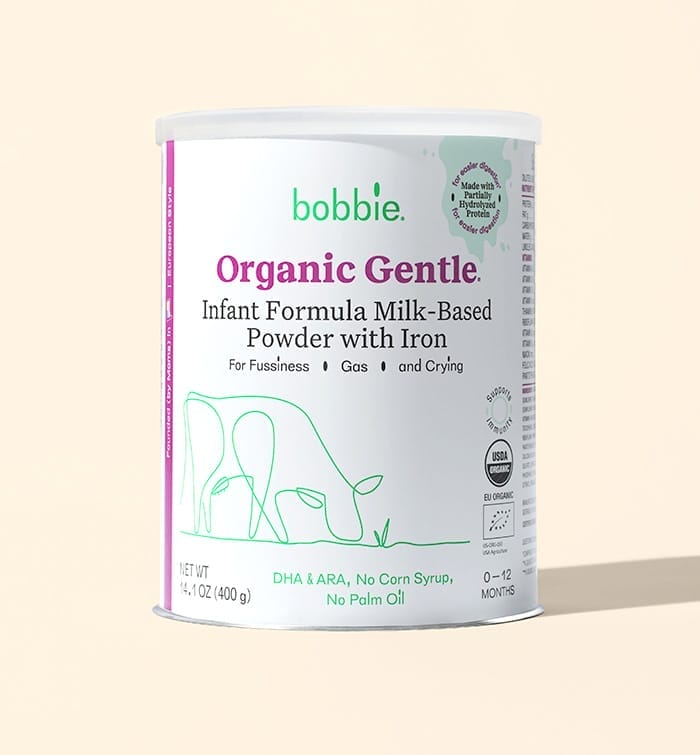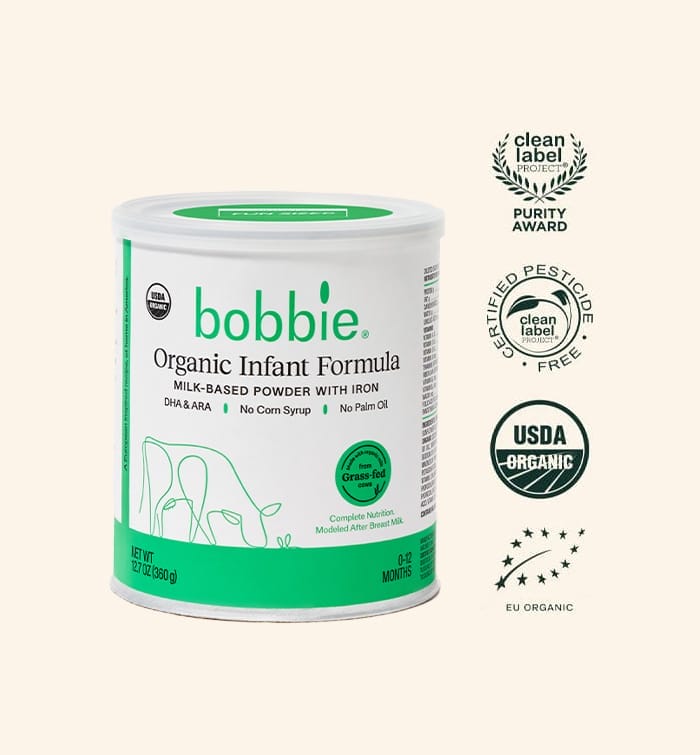We are proud to say that these posts are not sponsored. Our editorial team of Bobbie moms and writers personally select each featured product. If you buy something through our links, we may earn an affiliate commission, at no cost to you.
There are so many worries during the first year of a baby’s life, but few are more distressing to a new parent than a baby’s fussiness. Yep, babies cry…a lot. They cry because they’re hungry, cold, wet, bored, scared…the list goes on and on. Most of the times we can’t even figure out why they are crying. Though when we can soothe them, and get that happily fed milk drunk baby, it’s the best feeling in the world.
As parents, we want nothing more than for our babies to be happy, comfortable, and safe (spoiler alert, this does NOT end when your baby grows up!). As babies experience rapid growth in their first weeks of life, new parents learn to read signs of discomfort and attempt to provide relief from the real or perceived sources of fussiness.
When a baby shows signs of gastrointestinal distress (gas, loose stools, stomach pain), parents often think their newborn’s distress is due to what they’re eating, especially if they’re a formula-fed baby. In fact, parents will change their baby’s formula an average of 2-3 times in their baby’s first year of life.
We worry the formula we’re using is not the right infant formula for our baby. Is it the milk source? Can our baby be lactose intolerant? Here is expert advice from Bobbie Medical Advisors Pedro Prieto, MA, MS, PhD, and Jacqueline Winkelmann, MD, FAAP.
- The science behind lactose and lactose absorption
- How common is lactose intolerance in infants?
- Types of Lactose Intolerance
- Is lactose intolerance the same thing as a milk allergy?
- What makes lactose-Reduced baby formula different?
- Which babies should drink lactose-free or lactose-reduced formula?
- The takeaway regarding fussy babies
The science behind lactose and lactose absorption
The science behind the question of lactose intolerance can be a lot to take in, so bear with me. It’s essential to understanding the core of why your baby is experiencing discomfort and whether the culprit is lactose, or something else.
Lactose is a disaccharide (carbohydrate/sugar) made up of two sugars, glucose, and galactose. It is the main carbohydrate source in breastmilk and in many of the standard infant formulas on the market.
Lactose is crucial to keep cells functioning correctly during rapid developmental stages. But it does more than just supply cells with energy: it helps grow “healthy bacteria” in the intestines and facilitates calcium absorption from the gut.
However, it cannot be absorbed from the gastrointestinal (GI) system intact; it must be broken down, absorbed and transported into the bloodstream. The enzyme lactase, secreted by the intestinal cells, breaks down the lactose into more easily absorbable glucose and galactose molecules.
If there is a mutation in the gene that encodes lactase, or the body is unable to make it, the lactose molecule remains intact through the small and large intestine.
Lactose tends to draw water into the inside of the intestine and can also be fermented and produce gas, so the result is, you guessed it, symptoms of lactose intolerance include diarrhea, gas, bloating, and tummy pain!
To make matters worse, if there is no lactose absorbed for energy, baby will have to use the limited reserves of fat and protein to produce the necessary energy to maintain life. In other words, the inability to digest lactose can really wreak havoc on a baby’s (and an adult’s) GI system.

Shop Bobbie Organic Gentle Infant Formula
Bobbie Organic Gentle is the only baby formula in the U.S. market that offers 100% partially-hydrolyzed whey protein and 100% lactose as the carbohydrate source. Our gentle baby formula is easy on sensitive tummies to help alleviate fussiness and gas. Learn more about Bobbie Gentle.
How common is lactose intolerance in infants?
Lactose intolerance, medically known as lactase deficiency, is frequent in adults (up to 60%-70% of adults are lactose intolerant) but quite rare in infants.
The prevalence of lactose intolerance is most common in African Americans, Hispanics/Latinos, and Asians, while least prevalent in people of European descent.
During gestation, baby will produce an adequate amount of lactase by around 37 weeks, so full-term newborns have plenty of lactase, and lactase drops during childhood, adolescence and adulthood.
Lactose intolerance is rare in children younger than 5 years of age. It is most often seen in adolescents and young adults.

Shop Bobbie Organic Infant Formula
Bobbie Organic Infant Formula is a USDA Organic, EU-style infant formula that meets all FDA requirements. It is a complete nutrition milk-based powder modeled after breast milk and is easy on tummies. It is non-GMO and doesn't have corn syrup, palm oil, or maltodextrin. Learn more about Bobbie.
Types of Lactose Intolerance
1. Congenital Lactose Intolerance
Congenital lactose intolerance—officially known as Congenital Lactase Deficiency (CLD) is the inability to produce active lactase from birth. It is a RARE disorder (1 in 60,000 babies or less).
Newborns with this type of lactose intolerance will exhibit watery diarrhea shortly after consuming breastmilk or infant formula (remember, lactose is the primary carbohydrate found in milk from breastfeeding).
A diagnosis must be made quickly to prevent serious dehydration, and the baby must be started on a lactose-free baby formula.
2. Developmental (neonatal) Lactase Deficiency
A different type of lactose intolerance is associated with the maturity of a newborn’s gastrointestinal system.
This is called developmental lactase deficiency because it is associated with pre-term babies of less than 34 weeks of gestation who are born before their gastrointestinal tissues are mature enough to produce lactase. This deficiency is transient (it isn’t permanent), and it subsides as the intestines gain the ability to produce lactase.
3. Primary Lactase Deficiency
During late childhood, the production of lactase decreases. While the gene that encodes lactose may be fully functional, a different segment of DNA suppresses its expression.
This lactase deficiency is not universally distributed. Around 70% of the adult population has some level of lactose intolerance, but its incidence varies according to ethnicity and age; Hispanics, Southern Italians, Arabs, and Ashkenazi Jews have 60-100% incidences and Northern Europeans 2-30%. This type of intolerance is the one that is familiar to most adults.
4. Secondary Lactase Deficiency
In addition to other causes of intolerance to dairy products, there are instances, in adults, in which lactase synthesis is hampered by external factors.
After injury, surgery, infection or during periods of prolonged inflammation, the intestine may decrease the production of lactase, resulting in transient lactose intolerance.
In cases of this type of intolerance, it is necessary to manage the cause as well as the resulting intolerance simultaneously. We also see this in children when they have gastroenteritis, most commonly due to a virus.
Is lactose intolerance the same thing as a milk allergy?
No, not at all. Many parents confuse the terms lactose intolerance and milk allergy. While they may share similar symptoms, they are entirely different conditions.
Lactose intolerance is a problem related to the absence of a digestive enzyme, lactase, and deals with the carbohydrate source of formula or breastmilk.
A milk allergy involves an immune system reaction to the protein component of cow’s milk and cow’s milk products like ice cream. Cow’s milk allergy is sometimes called cow’s milk protein allergy, or CMPA.
While lactose intolerance is rare in children under the age of 5, CMPA is much more common (3-7% of babies) and usually diagnosed before 1 year of age. If your baby is having trouble digesting formula, it is much more likely to be a protein problem than a carbohydrate problem.
Symptoms of Cow’s milk allergy or CPMA
- Rash, hives, dry, scaly or itchy skin
- Digestive system symptoms: diarrhea, severe diarrhea, colic, constipation, abdominal pain, vomiting, reflux
- Respiratory symptoms: noisy breathing, coughing, runny nose
Treatment for CMPA involves specialized formulas with partially broken-down proteins. Your baby’s pediatrician or health care provider should guide you through this formula change.
What makes lactose-Reduced baby formula different?
Treatment for lactose intolerance involves offering baby a lactose-reduced formula, but the evolution of these “special formulas” has more to do with a demand on the market than true science.
Because lactose intolerance is so common in adults, parents might associate GI distress in their little one with lactose intolerance. We now understand this is quite rare in young children under the age of five.
In lactose-free or lactose-reduced formulas for lactose intolerant children, the lactose sugar has been replaced by other sugars. Infant formula companies tend to add corn syrup or sucrose (table sugar).
At this time, the FDA does not regulate the percentage of corn syrup and sucrose allowed in infant formula. In contrast, the EC (European Union Commission, equivalent of the US FDA) does regulate these carbohydrates, and limits them in European baby formulas.
Which babies should drink lactose-free or lactose-reduced formula?
While we now understand that true lactose intolerance is extremely rare in infants, there are a few circumstances where a lactose-free or lactose-reduced formula might be indicated.
Always discuss with your pediatrician or health care provider before starting or switching to any special formula for your child’s diet.
Premature babies
Since the lactase enzyme is produced close to 37 weeks of gestation, premature babies, babies born before that time, might benefit from a lactose-reduced formula until they can “catch-up” with enzyme production.
Babies born with Galactosemia
Galactosemia is a rare, inherited medical condition where babies are unable to safely digest galactose, one of the two sugars that make up lactose.
The condition is diagnosed at birth through newborn screening tests. Babies with Galactosemia can not tolerate breastmilk or standard infant formulas with lactose and must be given lactose-free formula that is not derived from cow’s milk.
Babies born with Congenital Lactase Deficiency
Congenital Lactase Deficiency is another very rare condition where babies cannot produce the lactase enzyme and therefore cannot digest lactose in either breastmilk or standard cow’s milk formula.

Shop Bobbie Organic Gentle Infant Formula
Bobbie Organic Gentle is the only baby formula in the U.S. market that offers 100% partially-hydrolyzed whey protein and 100% lactose as the carbohydrate source. Our gentle baby formula is easy on sensitive tummies to help alleviate fussiness and gas. Learn more about Bobbie Gentle.
The takeaway regarding fussy babies
As parents, we want our babies to be happy and content (so we can be happy and content as well!). When babies fuss or show signs of discomfort, we tend to want to find an answer, and many times the immediate reaction is—“it must be the formula.”
Keep in mind that breastfed babies fuss, too! If your baby is truly showing signs of significant distress— including skin rashes, GI, or respiratory symptoms, get medical advice from your baby’s pediatrician, dietitian, or health care provider.
Your health care provider can guide you through formula changes if necessary, so you can avoid getting caught up in the formula marketing hype and can make informed decisions for your baby and make sure they get enough calcium and Vitamin D. As babies’ systems develop and mature, they will be able to tolerate much more, so hang in there, this too shall pass!
Pedro Prieto is an infant formula industry veteran and holds a PhD, and MS degrees in Biochemistry and Nutrition as well as an MA on Administration of Higher Education Institutions.
Dr. Jacqueline Winkelmann is a board certified pediatrician in Southern California. They are both Bobbie Medical Advisors.

Shop Bobbie Organic Infant Formula
Bobbie Organic Infant Formula is a USDA Organic, EU-style infant formula that meets all FDA requirements. It is a complete nutrition milk-based powder modeled after breast milk and is easy on tummies. It is non-GMO and doesn't have corn syrup, palm oil, or maltodextrin. Learn more about Bobbie.
Sources:
Deng Y, Misselwitz B, Dai N, Fox M. Lactose Intolerance in Adults: Biological Mechanism and Dietary Management. Nutrients. 2015 Sep 18;7(9):8020-35. doi: 10.3390/nu7095380. PMID: 26393648; PMCID: PMC4586575.
Heyman, M.B., Lactose Intolerance in Infants, Children and Adolescents. Pediatrics (2006); 118;1279
Robayo-Torres CC, Nichols BL. Molecular differentiation of congenital lactase deficiency from adult-type hypolactasia. Nutr Rev. 2007 Feb;65(2):95-8. doi: 10.1111/j.1753-4887.2007.tb00286.x. PMID: 17345962.
Savilahti E, Launiala K, Kuitunen P. Congenital lactase deficiency. A clinical study on 16 patients. Arch Dis Child. 1983 Apr;58(4):246-52. doi: 10.1136/adc.58.4.246. PMID: 6847226; PMCID: PMC1627962.
Wanes D, Husein DM, Naim HY. Congenital Lactase Deficiency: Mutations, Functional and Biochemical Implications, and Future Perspectives. Nutrients. 2019 Feb 22;11(2):461. doi: 10.3390/nu11020461. PMID: 30813293; PMCID: PMC6412902.
Lactose Intolerance | Medline Plus

